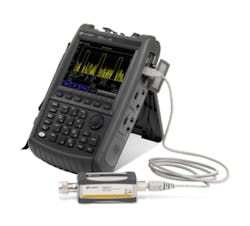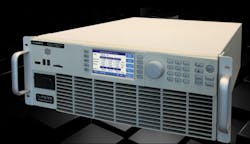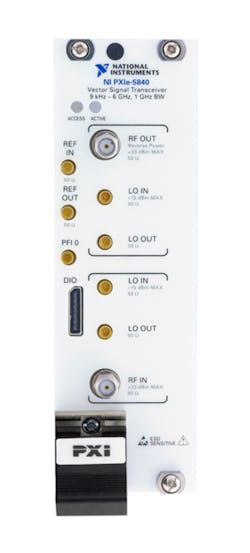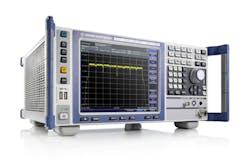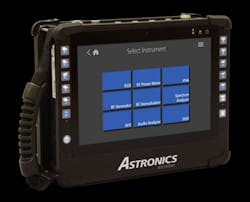The more things change the more they stay the same. That seems particularly true in the arena of military/aerospace test. Things are certainly changing, with the emergence of 50-GHz handheld analyzers; capable modular systems—usually PXI—able to handle mixed-signal and RF test; new instruments for V- and W-band measurements; and new software tools that simplify design, simulation, and test.
What stays the same, however, is the need to maintain test systems across decades in response to extended product life cycles.
Mike Dewey, director of marketing at Marvin Test Solutions (MTS), cited consolidation or commonality of test solutions as a key trend. “Whether it’s on the flightline or at I-level or depot level, test engineers and maintainers are looking for test solutions that are applicable to a range of aircraft, weapons systems, avionics, etc.” For example, he said, “MTS offers test solutions that incorporate MIL-STD-1760 bus capabilities (Figure 1) to enable ‘smart’ weapons test in support of a range of products and airframes on the flightline. The result is more comprehensive test capabilities and improved test asset utilization.
Courtesy of Marvin Test Solutions
“Extended product life cycles are also a trend we see in the MIL/aero test area,” Dewey said. “With extended product life cycles, the associated test-system life cycles are also being extended. Users are looking for suppliers and solutions that can support these long product life cycles by offering long-term product support as well as solutions and tools that facilitate existing test program set (TPS) support and migration. It’s an accepted fact that the life cycles for many MIL/aero systems and products continue to stretch out, requiring test systems/solutions that can effectively bridge the gap between legacy and next-generation test needs. Besides offering extended product support, MTS has been working with several major MIL/aero users to supply form-function replacement instrumentation, allowing these users to preserve their current investment in test programs and systems.”
Dewey added, “We continue to see the adoption of test systems based on modular platforms—particularly PXI. Ongoing advancements in instrumentation are enabling the creation of test systems that can provide compact, cost-effective, performance test solutions for flightline, depot, and manufacturing test in the areas of digital, mixed-signal, RF, and even microwave. Virtually all of MTS’s test platforms for I-level, depot, and manufacturing rely upon PXI as the core platform. The use of modular platforms offers customers the flexibility to adapt current test systems to future needs by leveraging their existing test assets, resulting in lower initial and incremental test costs.”
Dewey also addressed software tools. “The complexity of systems and subsystems continues to drive the complexity of test programs,” he said. “Software tools and the associated infrastructure that can simplify and speed up the test development and deployment process can help address this challenge. Consequently, MTS has focused on a range of software tools including software simulation of the complete system and UUT, TPS migration tools, and advanced signal routing tools, with the goal of expediting and simplifying the test programmer’s task for test development and test migration/verification.” He added that MTS’s ATEasy software, “… which is celebrating its 25th year of commercial deployment, continues to offer multigenerational compatibility, simplifying the overall maintenance and upgrades that might be needed to support test systems.” (See the sidebar “ATEasy reaches 25 years” following this article.)
Wide bandwidths and high frequencies
Marlo Manaloto, marketing brand manager at Keysight Technologies, said that longtime ongoing trends include the move to wider bandwidths and growing frequency ranges, which Keysight is addressing with various new products. “These solutions,” she said, “include ultrahigh-bandwidth scopes and new V- and W-band wideband smart mixers, which are low-cost external extensions to our X-Series analyzers for swept measurements up to 110 GHz and add wide-bandwidth (2+ GHz) measurement capabilities to our digitizers.
“Keysight focuses on key subsegments in the aerospace and defense industry where we feel we can provide the greatest impact and respond to large growth applications,” she added. “This includes a growing interest in electronic warfare (EW) and cyber warfare. For example, in EW, requirements to simulate various scenarios are getting more and more complicated so we continue to provide new features to our Multi-Emitter Scenario Generation software.”
Autotestcon 2016, Sept. 12-15 in Anaheim, CA, will provide an opportunity for Keysight, MTS, and other companies to highlight their latest products for MIL/aero test applications. Keysight, Manaloto said, will showcase its modular PXIe products, its Multi-emitter Scenario Generation for Electronic Warfare product, handheld FieldFox RF/microwave test solutions (Figure 2), and the company’s latest service offerings in calibration, repair, purchase alternatives, and eLearning.
Courtesy of Keysight Technologies
Manaloto said Keysight offers test equipment in the form factor users need: benchtop, small benchtop, handhelds, and modular. She said the Multi-emitter Scenario Generation for EW product uses off-the-shelf solutions to enable creation of a realistic multi-emitter environment with antenna scans and angle of arrival, streaming of pulse descriptor words (PDWs), and the capability to apply pulse arbitration and calibration to PDW data. She added that FieldFox is the industry’s first 50-GHz handheld analyzer for precise measurements on the bench or in the toughest working environments to meet MIL specs. Finally, she said, Keysight services include multi-OEM capabilities for one-stop shop calibration and a new eLearning platform starting with RF fundamentals.
Sources deployed for 30+ years
Herman vanEijkelenburg, director of marketing at Pacific Power Source (PPS), said, “One of the biggest challenges our MIL/aero customers face is the need to support existing test platforms much longer than originally planned. Test platforms are not being replaced in a timely matter due to budget constraints. This is shifting increased focus from developing new test systems to upgrading and supporting existing aging testers. As a result, test-and-measurement equipment manufacturers are asked to support their products for long periods of time, far longer than would be the case for industrial or commercial test systems. In the case of PPS, several of our programmable AC power sources have been deployed in these ATE systems for 30+ years, and we continue to support these with service, spares, upgrades, and in many cases new production units. One key advantage PPS offers is a common user interface and programming syntax across its entire product line, making upgrades easy without impacting TPSs.”
At Autotestcon, he said, “Pacific Power Source will be exhibiting its all new digital platform-based AFX Series of high power, programmable AC and DC power source systems (Figure 3). These brand new systems were designed from the ground up to support current and future generations of test systems with vastly superior power density and a smaller footprint than anything else available on the market today.”
Courtesy of Pacific Power Source
Citing the unit’s 15 kW of power in only a 4U 19-inch rack-mount chassis, vanEijkelenburg said, “Its incredibly small size and light weight allow power upgrades of aging power racks using existing available space by replacing older lower power sources with an AFX. Furthermore, the AFX not only provides single-, split-, or three-phase power output, it also supports DC output and any combination of AC+DC or DC+AC to expand test coverage when needed.”
From flightline test to PXI digital subsystems
Dewey at MTS cited several products his company will be highlighting at Autotestcon in addition to ATEasy:
- The MTS-3060 is an advanced, handheld, multifunction flightline tester for armament, combining more than 30 measurement channels with audio, video, and 1553/1760 test capabilities. It supports both legacy and “smart” armament systems for multiple aircraft. “More recently,” Dewey said, “we have expanded its capability by adding support for multiple operational flight profiles, further enhancing the product’s capability to address multiple aircraft, multiple aircraft blocks, and multiple armament systems.” He said the product also finds use as a troubleshooting/test tool because of its capability to emulate various weapon systems.
- The MTS-207 ultrarugged, open-architecture, PXI-based test systems are designed for I-level and flightline test and deployed in more than 20 countries supporting the advanced test needs for avionics and armament test on multiple aircraft. “The MTS-207 is the baseline platform for the MTS-206 Maverick/Hellfire Field Test Set, the MTS-209 Common Armament Test Set, the MTS-235 F-35 AME Test Set, the AN/TSM-205B Hellfire System Test Set, and the USAF’s PATS-70 test system for the A-10,” Dewey said.
- The PXI-based GENASYS platform offers performance functional test for mission-critical, high-value electronic assemblies, Dewey said. “Selected by two of the four major MIL/aero primes for testing satellite systems, subsystems, and advanced display systems, MTS recently has expanded the GENASYS product line with the addition of the GX7017 chassis,” he added. “Building on the innovative, performance architecture of the GENASYS switching subsystem, the GX7017 provides digital, analog, and high-performance switching capability within a single, compact, 6U PXI chassis footprint. Featuring high-density signal switching for board- and system-level functional test with an ‘any-resource to any-pin’ architecture, the GX7017 can accommodate any of the GENASYS switch modules, providing up to 2,304 multiplexed, hybrid I/O pins without cabled connections via a MAC Panel 6U SCOUT receiver. In addition, the GX7017 can support up to 256 performance digital test channels providing a high-performance and compact functional test platform for mixed-signal test applications. The GX7017 chassis is available as a subsystem or as part of the TS-321, Marvin Test Solutions’ single-bay GENASYS functional test platform.”
Dewey said MTS also will showcase its portfolio of PXI digital subsystems for component, board, and system-level test. “Our most advanced digital subsystem, the GX5296, represents the state of the art for high-performance, PXI digital subsystems, offering timing per pin, subnanosecond edge placement, a PMU per pin, and the highest channel density in the industry,” he said. “Up to 512 125-MHz digital channels can be synchronized in a single PXI chassis, supporting the testing of complex digital devices, SoC devices, and board-level products with capabilities that have, until now, only been available in proprietary ATE systems.”
More Autotestcon plans
Other companies planning to exhibit at Autotestcon include VTI Instruments, which will highlight its aircraft testing capabilities. The company tests airframes, entertainment systems, engines, auxiliary power units, wings, control surfaces, landing gear, radar, and weapons stores and launchers. Specifically, the company indicated it would highlight the EMX-4250 and EMX-4251 Smart Dynamic Signal Analyzers, which VTI says “… incorporate best-in-class analog design methodology to deliver industry-leading measurement accuracy.” These PXIe instruments serve a range of applications including noise, vibration, and harshness; machine condition monitoring, rotational analysis, acoustic test, modal test, and general-purpose high-speed digitization and signal analysis.
Virginia Panel said it would exhibit its Snap-In-Modular (SIM) VTAC right-angle insert. Capable of speeds beyond 10 Gb/s, the SIM VTAC right-angle insert serves a variety of applications that require a high-speed PCB solution. The inserts are available individually or as full-size or small PCB adapters. The small PCB solution comes with a retention insert to provide added rigidity and ensure proper connections between the right-angle insert and the double-ended SIM VTAC insert. The SIM technology is compatible with many commercial-off-the-shelf interfaces, including USB 3.0, RJ45, HDMI, RosenbergerHSD, Mini-SAS HD, and HDMI.
In addition, Elma Electronic plans to highlight its rugged, high-performance embedded vision system that incorporates four configurable Camera Link ports and a front-removable, multiterabyte storage bay with an SATA III interface. Powered by an Intel Quad Core i7 processor, the new OptiSys-5101 features a high-definition image frame grabber suitable for optical inspection and video capture. A miniPCIe expansion site facilitates easy I/O customization. The system offers support for I/O options including HDMI, USB 2.0, GigE RJ45, ARINC 429, and CANbus.
And Pico Technology will demonstrate two-channel, four-channel, and mixed-signal PicoScope models that have the functionality of an oscilloscope plus a logic analyzer (on MSO models), a spectrum analyzer, a function generator, and an arbitrary waveform generator. PicoScope 2000B Series models are equipped with deep buffer memory from 32 to 128 MS and feature bandwidths of 50, 70, or 100 MHz supported with sampling speeds to 1 GS/s and hardware acceleration to deliver more than 80,000 waveforms-per-second update rates.
From PXIe VSTs to radio test sets
As the September print issue goes to press, other Autotestcon exhibitors had not detailed specific intentions for the event, but announcements over the past few months suggest what they might highlight. For example, in July National Instruments (NI) announced a second-generation vector signal transceiver (VST): the NI PXIe-5840 module (Figure 4), which the company calls the world’s first 1-GHz-bandwidth VST designed to solve the most challenging RF design and test applications.
Courtesy of National Instruments
The NI PXIe-5840 combines a 6.5-GHz RF vector signal generator, a 6.5 GHz vector signal analyzer, high-performance user-programmable FPGA, and high-speed serial and parallel digital interfaces into a single two-slot PXI Express module. With 1 GHz of bandwidth, the latest VST is suited for a range of applications including 802.11ac/ax device testing, mobile/Internet of Things device testing, 5G design and testing, RFIC testing, and radar prototyping.
“The NI VST gives us incredible flexibility that accommodates a more focused test solution in a smaller footprint than traditional benchtop instruments. The reprogrammable FPGA allows us the ability to quickly tailor the system to meet specific test objectives while maintaining a common architecture across many test platforms,” said Don Miller, senior staff engineer, Lockheed Martin Space Systems, in a press release.
Pickering Interfaces announced in June that it is expanding its range of PCI fault insertion switching products with the introduction of two modules (models 50-200 and 50-201) designed for use with differential serial interfaces. These modules will find application in testing the response of safety-critical communication systems used in automotive and aerospace environments.
Also in June ADLINK Technology announced the release of the MVP-6000 Series, the first in its new line of fanless embedded computing platforms for use in harsh environments. The MVP-6000 Series incorporates 6th generation Intel Core processors, which boost compute performance by up to 30% over previous generation CPUs.
In a June announcement, JTAG Technologies introduced a family of hardware adapters designed for testing a variety of DIMM and SODIMM sockets (sizes and styles) using a JTAG/boundary-scan controller and supporting software.
The JT 2127-Flex system comprises two basic elements: a high-speed multichannel IO module (the JT 2127/DMU) and a personality adapter for the chosen DIMM type (the JT 2127-Flex). The combination of the DMU and Flex adapter allows test signals to be sent to and from the boundary-scan source device on the UUT performing a thorough check for open pins and short circuits. In addition the voltages on the power pins of the DIMM socket are measured.
Chroma in June released the 63224A 24-kW DC electronic load. Designed for testing a range of power conversion products including AC/DC and server power supplies, DC/DC converters, EV batteries, automotive charging stations, and other power electronics components, these loads can be synchronously paralleled up to 480 kW and dynamically synchronized for generating complex multichannel transient profiles. The 300% peak overpower capability provides extra headroom for fault-condition simulations in automotive batteries and fuel cells.
Last May at the International Microwave Symposium, Boonton and Noisecom, both Wireless Telecom Group companies, highlighted enhanced products: a wideband USB power sensor and a carrier-to-noise generator, respectively. Boonton added a new fast measurement mode to the 55 Series USB wideband power sensor, which includes 6-, 18- and 40-GHz models. Noisecom highlighted a new CNG-EbNo programmable precision carrier-to-noise generator with an integrated spectrum analyzer designed for communication systems data streams that include multiple carriers in the frequency band.
At the end of May and after IMS, Rohde & Schwarz said it has expanded its portfolio of midrange signal and spectrum analyzers. The new R&S FSVA (Figure 5) offers a 160-MHz analysis bandwidth over its entire frequency range. The company said it is the only analyzer in its class to do so at frequencies between 26.5 GHz and 40 GHz, adding that with its enhanced phase noise performance, the instrument offers users high accuracy in spectral measurements on narrowband modulated signals and in phase noise measurements. Like the R&S FSV, the R&S FSVA is available in five models covering frequency ranges from 10 Hz to 4 GHz, 7 GHz, 13.6 GHz, 30 GHz, and 40 GHz. The R&S FSVA supports all R&S FSV hardware functions and firmware options. Plus, the R&S FSV and the R&S FSVA are fully remote-control compatible for use in complex test setups.
Courtesy of Rohde & Schwarz
Also in May, Universal Switching updated its System MS2010A DC to 18-GHz modular matrix, which now is available in configurations up to 12×12 in a 2RU package that is 24 inches deep. The company estimates that a user can change a relay element in the field in one to two minutes while the unit is on. Applications include ATE and satellite installations. And in April, Universal Switching introduced the SLX128 modular 128 x 128 L-band matrix. The company says it eliminates a rat’s nest of multicouplers, manual patch bays, and patch cords and is designed for routing L-band signals (850 to 2450 MHz) while being modular. The matrix is configurable up to 128×128 in increments of eight and can find use in satellite ground stations.
Courtesy of Astronics
Finally, in April Astronics introduced the CTS 6000 Series radio test set, (Figure 6), which incorporates nine test capabilities into a single tester with an easy-to-use, modern touchscreen interface for testing radio communications systems at the factory, at the depot, or in the field. The CTS 6000 is suitable for use by all branches of the military, TSA, police, fire, private security, and airline personnel requiring secure, reliable radio communications. It provides extensive test capability for any radio system to reduce testing time and cost, maintenance and calibration costs, lifecycle ownership costs, and the number of “no fault found” results. Users can test tactical handsets, amplifiers, antennae, and any other component of a radio system.
ATEasy reaches 25 years
July 2016 marked the 25th year of ATEasy’s commercial deployment. “Featuring multigenerational compatibility and designed specifically for functional ATE applications, ATEasy is the only test executive/test-development product with comprehensive simulation capabilities for both the test system resources and the UUT,” said Mike Dewey, director of marketing at Marvin Test Solutions. The simulation capability comes with today’s version 9, which also incorporates source/version control. Like previous versions of ATEasy, version 9 maintains backwards compatibility between file formats and its programming language.
What’s now Marvin Test Solutions was Geotest at its founding in 1988. According to Loofie Gutterman, cofounder and now president of MTS, ATEasy was on the company’s roadmap from the beginning. “Our goal was to come up with a product that hardware engineers and software engineers alike can use,” he said in a recent phone interview. “So it’s going to be easy enough that hardware engineers can use it, but it’s going to be robust enough that software engineers can use it.”
ATEasy today, he said, “which is [version] 9 going on 10,” has a lot more functionality than the 1991 version, but the overall concept is the same: a single integrated environment that supports development, debug, integration, implementation, and maintenance. But it’s also an open-architecture environment that lets you use external software components.
Dewey elaborated on version 9’s capabilities for today’s user. “With software simulation, you are able to fully simulate a test system and UUT (not just low-level driver code), allowing the test developer to debug and verify the test program without hardware and without modifying the test program, expediting the program development and verification process,” he said. “Additionally, MTS has recently introduced ATEasy-Lite, a full-featured, cost-effective test executive and test development software suite that can be bundled with ATE systems supplied by OEMs. Applicable to all sectors including commercial, industrial, automotive, military, and aerospace markets and with more than 25 years of field-proven deployment, ATEasy offers a full spectrum of ATE features including simulation, a hardware abstraction layer architecture, and unrivaled long-term support and version compatibility that ensure extended system life-cycle support.”
For more information
- ADLink Technology
- Astronics Test Systems
- Chroma
- ELMA Electronic
- JTAG Technologies
- Keysight Technologies
- MAC Panel
- Marvin Test Solutions
- National Instruments
- Pacific Power Source
- Pickering Interfaces
- Pico Technology
- Rohde & Schwarz
- Universal Switching
- Virginia Panel
- VTI Instruments
- Wireless Telecom Group
About the Author

Rick Nelson
Contributing Editor
Rick is currently Contributing Technical Editor. He was Executive Editor for EE in 2011-2018. Previously he served on several publications, including EDN and Vision Systems Design, and has received awards for signed editorials from the American Society of Business Publication Editors. He began as a design engineer at General Electric and Litton Industries and earned a BSEE degree from Penn State.


